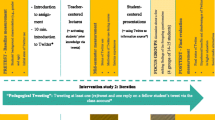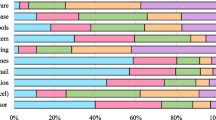Abstract
The availability of social media in biomedical education is rapidly expanding. However, there is little information comparing the utility of different social media platforms. The authors sought to describe and evaluate a student-led medical education tool, ObGyn Delivered, that uses three social media platforms (Facebook, Instagram, and Twitter) in order to understand each platform’s potential roles, benefits, and barriers and describe their advantages and limitations. Medical educators utilizing social media tools may benefit from focusing their efforts on the strengths of each platform to communicate different messages, provide unique content, and to reach a maximal number of potential users.



Similar content being viewed by others
References
Chaffey D. Our compilation of the latest social media statistics of consumer adoption and usage of social networking platforms. Smart Insights. 2020. https://www.smartinsights.com/social-media-marketing/social-media-strategy/new-global-social-media-research/. Accessed 5 Dec 2020.
Cheston CC, Flickinger TE, Chisolm MS. Social media use in medical education: A systematic review. Acad Med. 2013;88(6):893–901.
Sherbino J. Making change in medical education. Med Educ. 2019;53(7):649–51. https://doi.org/10.1111/medu.13908.
Rashid A, Prosser-Snelling E, Southern L, Molloy A. The endless potential of social media in medical education. Med Educ. 2015;49(9):947. https://doi.org/10.1111/medu.12792.
Whyte W, Hennessy C. Social Media use within medical education: A systematic review to develop a pilot questionnaire on how social media can be best used at BSMS. MedEdPublish. 2017:1–36. https://doi.org/10.15694/mep.2017.000083.
Roberts DH, Newman LR, Schwartzstein RM. Twelve tips for facilitating millennials’ learning. Med Teach. 2012;34(4):274–8. https://doi.org/10.3109/0142159X.2011.613498.
Hopkins L, Hampton BS, Abbott JF, Buery-Joyner SD, Craig LB, Dalrymple JL, et al. To the point: Medical education, technology, and the millennial learner. Am J Obstet Gynecol. 2018;218(2):188–92. https://doi.org/10.1016/j.ajog.2017.06.001.
Waljee JF, Chopra V, Saint S. Mentoring millennials. JAMA. 2018;319(15):1547–8. https://doi.org/10.1001/jama.2018.3804.
Bringman-Rodenbarger L, Hortsch M. How students choose E-learning resources: The importance of ease, familiarity, and convenience. FASEB BioAdv. 2020;2(5):286–95. https://doi.org/10.1096/fba.2019-00094.
Hollinderbäumer A, Hartz T, Ückert F. Education 2.0—how has social media and Web 2.0 been integrated into medical education? A systematical literature review. GMS Z Med Ausbild. 2013;30(1):1–12. https://doi.org/10.3205/zma000857.
Bahner DP, Adkins E, Patel N, Donley C, Nagel R, Kman NE. How we use social media to supplement a novel curriculum in medical education. Med Teach. 2012;34(6):439–44. https://doi.org/10.3109/0142159X.2012.668245.
Lasker R, Vicneswararajah N. Using Twitter to teach problem-based learning. Med Educ. 2015;49(5):531. https://doi.org/10.1111/medu.12717.
Flynn L, Jalali A, Moreau KA. Learning theory and its application to the use of social media in medical education. Postgrad Med J. 2015;91(1080):556–60. https://doi.org/10.1136/postgradmedj-2015-133358.
Avci K, Celikden SG, Eren S, Aydenizoz D. Assessment of medical students’ attitudes on social media use in medicine: A cross-sectional study. BMC Med Educ. 2015;15:18. https://doi.org/10.1186/s12909-015-0300-y.
El Bialy S, Jalali A. Go Where the students are: A comparison of the use of social networking sites between medical students and medical educators. JMIR Med Educ. 2015;1(2):e7. https://doi.org/10.2196/mededu.4908.
Junco R. The relationship between frequency of Facebook use, participation in Facebook activities, and student engagement. Comput Educ. 2012;58(1):162–71. https://doi.org/10.1016/j.compedu.2011.08.004.
Hennessy CM, Kirkpatrick E, Smith CF, Border S. Social media and anatomy education: Using twitter to enhance the student learning experience in anatomy. Anat Sci Educ. 2016;9(6):505–15. https://doi.org/10.1002/ase.1610.
Kirschner PA, Karpinski AC. Facebook (R) and academic performance. Comput Hum Behav. 2010;26(6):1237–45. https://doi.org/10.1016/j.chb.2010.03.024.
Huang CJ. Social network site use and academic achievement: A meta-analysis. Comp & Educ. 2018;119:76–83. https://doi.org/10.1016/j.compedu.2017.12.010.
Ekarattanawong S, Chamod P, Thuppia A, Mathuradavong N, Pattharanitima P, Bhamarapravatana K, et al. Using Facebook for ongoing learning promotes higher national licensing examination success. Med Sci Educ. 2019;29:241–5.
Davis WM, Ho K, Last J. Advancing social media in medical education. CMAJ. 2015;187(8):549–50. https://doi.org/10.1503/cmaj.141417.
Al-Bahrani A, Patel DN, Sheridan B. Engaging students using social media: The students’ perspective. Int Rev Econ Educ. 2015;19:36–50.
George DR, Rovniak LS, Kraschnewski JL. Dangers and opportunities for social media in medicine. Clin Obstet Gynecol. 2013;56(3):453–62. https://doi.org/10.1097/GRF.0b013e318297dc38.
Maben-Feaster RE, Stansfield RB, Opipari A, Hammoud MM. Evaluating patient perspectives of provider professionalism on Twitter in an academic obstetrics and gynecology clinic: Patient survey. J Med Internet Res. 2018;20(3):e78. https://doi.org/10.2196/jmir.8056.
Kofinas JD, Varrey A, Sapra KJ, Kanj RV, Chervenak FA, Asfaw T. Adjunctive social media for more effective contraceptive counseling: A randomized controlled trial. Obstet Gynecol. 2014;123(4):763–70. https://doi.org/10.1097/AOG.0000000000000172.
Omurtag K, Turek P. Incorporating social media into practice: A blueprint for reproductive health providers. Clin Obstet Gynecol. 2013;56(3):463–70. https://doi.org/10.1097/GRF.0b013e3182988cec.
Fogelson NS, Rubin ZA, Ault KA. Beyond likes and tweets: An in-depth look at the physician social media landscape. Clin Obstet Gynecol. 2013;56(3):495–508. https://doi.org/10.1097/GRF.0b013e31829e7638.
Antheunis ML, Tates K, Nieboer TE. Patients’ and health professionals’ use of social media in health care: Motives, barriers and expectations. Patient Educ Couns. 2013;92(3):426–31. https://doi.org/10.1016/j.pec.2013.06.020.
Anderson M, Jiang J. Teens, social media & technology. Pew Research Center. 2018. https://www.pewresearch.org/internet/2018/05/31/teens-social-media-technology-2018. Accessed 5 Dec 2020.
Ortiz-Ospina E. The rise of social media. Our World in Data. 2019. https://ourworldindata.org/rise-of-social-media. Accessed 5 Dec 2020.
Shafer S, Johnson MB, Thomas RB, Johnson PT, Fishman EK. Instagram as a vehicle for education: What radiology educators need to know. Acad Radiol. 2018;25(6):819–22. https://doi.org/10.1016/j.acra.2018.03.017.
Park JH, Christman MP, Linos E, Rieder EA. Dermatology on Instagram: An analysis of hashtags. J Drugs Dermatol. 2018;17(4):482–4.
Ranginwala S, Towbin AJ. Use of Social Media in Radiology Education. J Am Coll Radiol. 2018;15(1 Pt B):190–200. https://doi.org/10.1016/j.jacr.2017.09.010.
Lee LMJ, Gould DJ. Educational implications of a social networking application, Twitter, for anatomical sciences. Med Sci Educ. 2014;24:273–8. https://doi.org/10.1007/s40670-014-0048-8.
Chretien KC, Tuck MG, Simon M, Singh LO, Kind T. A digital ethnography of medical students who use Twitter for professional development. J Gen Intern Med. 2015;30(11):1673–80. https://doi.org/10.1007/s11606-015-3345-z.
Jaffe RC, O’Glasser AY, Brooks M, Chapman M, Breu AC, Wray CM. Your @Attending will #Tweet you now: Using Twitter in medical education. Acad Med. 2020;online.
Magid MS, Schindler MK. Weekly open-book open-access computer-based quizzes for formative assessment in a medical school general pathology course. J Int Assoc Med Sci Educ. 2007;17:45–51.
Wenger SL, Hobbs GR, Williams HJ, Hays MA, Ducatman BS. Medical student study habits: Practice questions help exam scores. J Int Assoc Med Sci Educ. 2009;19(4):170–2.
Wynter L, Burgess A, Kalman E, Heron JE, Bleasel J. Medical students: What educational resources are they using? BMC Med Educ. 2019;19(1):36. https://doi.org/10.1186/s12909-019-1462-9.
Ventola CL. Social media and health care professionals: Benefits, risks, and best practices. P&T. 2014;39(7):491–520.
Tan C. Regulating content on social media. London: UCL Press; 2018.
Pew Research Center. Social media fact sheet. Pew Research Center. 2019. https://www.pewresearch.org/internet/fact-sheet/social-media/. Accessed 5 Dec 2020.
Sterling M, Leung P, Wright, Bishop TF. The use of social media in graduate medical education: A systematic review. Acad Med. 2017;92(7):1043–56.
Hortsch M. How to make educational lemonade out of a didactic lemon: The benefits of listening to your students. Anat Sci Educ. 2019;12(5):572–6. https://doi.org/10.1002/ase.1861.
Acknowledgements
The authors wish to thank Dr. J. Woolliscroft for his encouragement and helpful advice.
Author information
Authors and Affiliations
Corresponding author
Ethics declarations
This study received a notice of exemption from the University of Michigan Institutional Review Board (HUM000182315).
Conflict of Interest
The authors declare that they have no conflict of interest.
Additional information
Publisher’s Note
Springer Nature remains neutral with regard to jurisdictional claims in published maps and institutional affiliations.
Supplementary Information
Below is the link to the electronic supplementary material.
Rights and permissions
About this article
Cite this article
Carman, K.L., Minns, A., Garber, S. et al. ObGyn Delivered: Social Media Serving Medical Students’ Learning Needs. Med.Sci.Educ. 31, 827–836 (2021). https://doi.org/10.1007/s40670-021-01226-w
Accepted:
Published:
Issue Date:
DOI: https://doi.org/10.1007/s40670-021-01226-w




